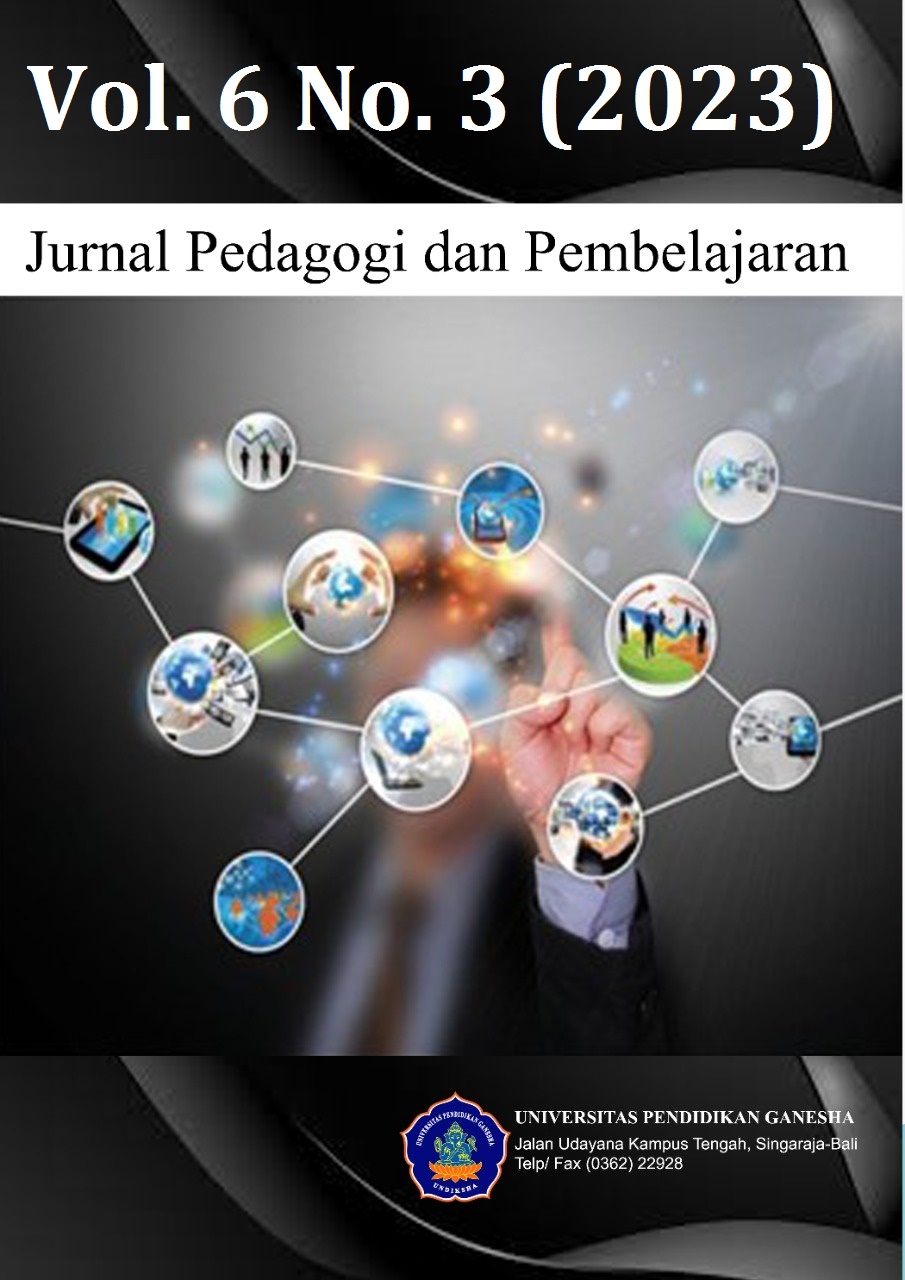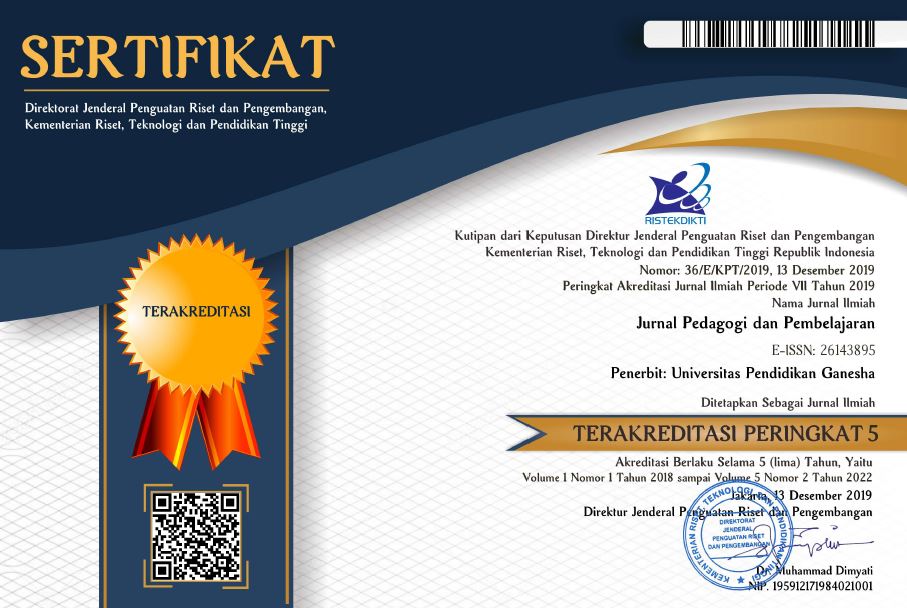School Violence Among Undergraduate Students in Kwara State: Implications for Counselling
DOI:
https://doi.org/10.23887/jp2.v6i3.67814Keywords:
School Violence, Counseling Implications, Undergraduate StudentsAbstract
School violence has recently emerged as a widespread scenario and a primary concern globally. In Nigeria, hardly a day goes by without official or unofficial reports of some form of violence occurring in schools and manifesting in various forms, such as bullying, shootings, sexual harassment, kidnapping, and many others. Several studies show that violence in schools has a real impact on student's physical and mental health and academic achievement. Therefore, this study focuses on school violence among undergraduate students in Kwara State and its implications for counseling. This research is included in qualitative research. The type of research used is library research or literature study. The techniques used to collect data are observation and documentation. The technique used to analyze data is qualitative descriptive analysis. The results of the research are that the presence of violence has a significant impact on the field of education. Violence in educational institutions becomes an obstacle to achieving teenagers' dreams. The influence of peer groups has a significant influence on student behavior, particularly drug and alcohol use, incidents of rape and sexual harassment, involvement in examination malpractice, and reduced motivation to study.
References
Ardi, Z., Putra, M. R. M., & Ifdil, I. (2017). Ethics And Legal Issues In Online Counseling Services: Counseling Principles Analysis. Jurnal Psikologi Pendidikan dan Konseling: Jurnal Kajian Psikologi Pendidikan dan Bimbingan Konseling, 3(0), 15. https://doi.org/10.26858/jpkk.v0i0.3657. DOI: https://doi.org/10.26858/jpkk.v0i0.3657
Aroyewumi, B. A., Adeyemo, S. ., & Chioma, C. (2023). Aggressive behavior: Examining the psychological and demographic factors among university students in Nigeria. Clinical Psychology, 10(1). https://doi.org/10.1080/23311908.2022.2154916. DOI: https://doi.org/10.1080/23311908.2022.2154916
Austin, A. E., Shanahan, M., Frank, M., Reyes, H. L. M., Ammerman, A., & Short, N. A. (2023). State expansion of supplemental nutrition assistance program eligibility and rates of interpersonal violence. Preventive Medicine, 175. https://doi.org/10.1016/j.ypmed.2023.107725. DOI: https://doi.org/10.1016/j.ypmed.2023.107725
Badriyati, S., & Usman, N. (2020). The Principal’s Policy in Developing Religious Culture. International Symposium on Humanities, Economics and Social Sciences. https://doi.org/10.2991/assehr.k.200529.061. DOI: https://doi.org/10.2991/assehr.k.200529.061
Bowen, G. A. (2009). Document analysis as a qualitative research method. Qualitative Research Journal, 9(2), 27–40. https://doi.org/10.3316/QRJ0902027. DOI: https://doi.org/10.3316/QRJ0902027
Buchanan, J., Pressick-Kilborn, K., & Maher, D. (2019). Promoting environmental education for primary school-aged students using digital technologies. Eurasia Journal of Mathematics, Science and Technology Education, 15(2). https://doi.org/10.29333/ejmste/100639. DOI: https://doi.org/10.29333/ejmste/100639
Chen, J.-K., Lin, L., Hong, J. S., & Wang, L.-C. (2023). Temporal association of parental corporal punishment with violence in school and cyberbullying among adolescents. Child Abuse & Neglect. https://doi.org/10.1016/j.chiabu.2023.106251. DOI: https://doi.org/10.1016/j.chiabu.2023.106251
Christakis, D. A., & Zimmerman, F. J. (2007). Violent television viewing during preschool is associated with antisocial behavior during school age. Pediatrics, 120(5), 993–999. https://doi.org/10.1542/peds.2006-3244. DOI: https://doi.org/10.1542/peds.2006-3244
Cornel, D., & J., M. (2018). State-wide implication of threat Assessment in Virginia K-12 Schools. Contemporary School Psychology, 22(1). https://doi.org/10.1007/s40688-017-0146-x. DOI: https://doi.org/10.1007/s40688-017-0146-x
Cornell, D. G., & Allen, K. (2011). Development, evaluation, and future directions of the Virginia Student Threat Assessment Guidelines. Journal of School Violence, 10(1). https://doi.org/10.1080/15388220.2010.519432. DOI: https://doi.org/10.1080/15388220.2010.519432
Crepeau-Hobson, F., & Filaccio, M. (2005). Violence Prevention after Columbine: A Survey of High School Mental Health Professionals. Children & Schools, 27(3). https://doi.org/10.1093/cs/27.3.157. DOI: https://doi.org/10.1093/cs/27.3.157
Eapen, D. J., Tsusaki, R. B., Mullassery, D. G., Goolsby, C., Lee, K., & Wardell, D. W. (2023). A Systematic Review of Women’s Experiences of Interpersonal Violence During the COVID-19 Pandemic. Nursing for Women’s Health, 19. https://doi.org/10.1016/j.nwh.2023.07.003. DOI: https://doi.org/10.1016/j.nwh.2023.07.003
Escuadra, C. J., Magallanes, K., Lee, S., & Chung, J. Y. (2023). Systematic analysis on school violence and bullying using data mining. Children and Youth Services Review, 150. https://doi.org/10.1016/j.childyouth.2023.107020. DOI: https://doi.org/10.1016/j.childyouth.2023.107020
Ferrara, P., Franceschini, G., & Corsello. (2019). Physical, psychological and social impact of school violence on children. Italian Journal Pediatrics, 45(76). DOI: https://doi.org/10.1186/s13052-019-0669-z
Flannery, D. J., Scholer, S. J., & Noriega, I. (2023). Bullying and School Violence. Pediatric Clinics of North America, 70(6). https://doi.org/10.1016/j.pcl.2023.06.014. DOI: https://doi.org/10.1016/j.pcl.2023.06.014
Fung, H. W., Cong, C. W., Tan, C.-S., Yuan, G. F., Liu, C., & He, K. L. (2023). Is teacher violence a form of betrayal trauma? Relationship with mental health problems among young adults. Child Abuse & Neglect, 145. https://doi.org/10.1016/j.chiabu.2023.106436. DOI: https://doi.org/10.1016/j.chiabu.2023.106436
Gilligan, J. (1997). Violence: Reflections on a National Epidemic. Vintage Books.
Henry, S., & Lanier, M. M. (1998). The prism of crime: Arguments for an integrated definition of crime. Justice Quarterly, 15(4). https://doi.org/10.1080/07418829800093921. DOI: https://doi.org/10.1080/07418829800093921
Huri, A., & Marwanto, M. (2019). Implementation of Model Strengthening Religious Character Education and Nationalists at Muhammadiyah Plus Elementary School City of Salatiga Academic Year 2017/2018. MUDARRISA: Jurnal Kajian Pendidikan Islam, 11(2), 101–113. https://doi.org/10.18326/mdr.v11i2.101-113. DOI: https://doi.org/10.18326/mdr.v11i2.101-113
Ismael-Simental, E., Rodriguez-Medina, L., & Cuenca, A. L. (2023). Disruptive culture: Violence and cultural self-management in Tijuana, 2001–2017. City, Culture and Society, 32. https://doi.org/10.1016/j.ccs.2023.100504. DOI: https://doi.org/10.1016/j.ccs.2023.100504
Johnson, C. L., Wilcox, P., & Peterson, S. (2019). Stressed out and strapped: Examining the link between psychological difficulties and student weapon carrying and use. Criminal Justice and Behavior, 46(7). https://doi.org/10.1177/0093854819826110. DOI: https://doi.org/10.1177/0093854819826110
Kadafi, A., Alfaiz, A., Ramli, M., Asri, D. N., & Finayanti, J. (2021). The impact of islamic counseling intervention towards students’ mindfulness and anxiety during the covid-19 pandemic. Islamic Guidance and Counseling Journal, 4(1), 55–66. https://doi.org/10.25217/igcj.v4i1.1018. DOI: https://doi.org/10.25217/igcj.v4i1.1018
Kaspar, V. (2013). Mental health of Aboriginal children and adolescents in violent school environments: Protective mediators of violence and psychological/nervous disorders. Social Science & Medicine, 81. https://doi.org/10.1016/j.socscimed.2012.12.011. DOI: https://doi.org/10.1016/j.socscimed.2012.12.011
Kaufman-Parks, A. M., Longmore, M. A., Manning, W. D., & Giordano, P. C. (2023). Understanding the effect of adverse childhood experiences on the risk of engaging in physical violence toward an intimate partner: The influence of relationship, social psychological, and sociodemographic contextual risk factors. Child Abuse & Neglect, 144. https://doi.org/10.1016/j.chiabu.2023.106381. DOI: https://doi.org/10.1016/j.chiabu.2023.106381
Kemal, S., Nwabuo, A., & Hoffmann, J. (2023). Mental Health and Violence in Children and Adolescents. Pediatric Clinics of North America, 70(6). https://doi.org/10.1016/j.pcl.2023.06.011. DOI: https://doi.org/10.1016/j.pcl.2023.06.011
Lowry, R., Parker, E. M., Ratto, J. D., Krause, K., & Hertz, M. F. (2023). Associations Between Exposure to School Violence and Weapon Carrying at School. American Journal of Preventive Medicine, 65(3). https://doi.org/10.1016/j.amepre.2023.03.007. DOI: https://doi.org/10.1016/j.amepre.2023.03.007
Mayer, M., & Furlong, M. J. (2014). The Handbook of School Violence and School Safety: International Research and Practice. Routledge.
Obaki, S. O. (2017). Impact of Classroom Environment on Childrens Social Behavior. International Journal of Education and Practice, 5(1), 1–7. https://doi.org/10.18488/journal.61/2017.5.1/61.1.1.7. DOI: https://doi.org/10.18488/journal.61/2017.5.1/61.1.1.7
Pérez-Jorge, D., Alonso-Rodríguez, I., Arriagada-Venegas, M., & Ariño-Mateo, E. (2023). Restorative methods as a strategy for the prevention of violence and bullying in primary and secondary schools in Mexico: An exploratory study. Heliyon, 9(7). https://doi.org/10.1016/j.heliyon.2023.e18267. DOI: https://doi.org/10.1016/j.heliyon.2023.e18267
Rajan, S., Reeping, P. M., Ladhani, Z., Vasudevan, L. M., & Branas, C. C. (2022). Gun violence in K-12 schools in the United States: Moving towards a preventive (versus reactive) framework. Preventive medicine, 165. https://doi.org/10.1016/j.ypmed.2022.107280. DOI: https://doi.org/10.1016/j.ypmed.2022.107280
Riddell, J., Robins, L., Brown, A., Sherbino, J., Lin, M., & Ilgen, J. S. (2020). Independent and interwoven: A qualitative exploration of residents’ experiences with educational podcasts. Academic Medicine, 95(1), 89–96. https://doi.org/10.1097/ACM.0000000000002984. DOI: https://doi.org/10.1097/ACM.0000000000002984
Rosen, L. H., Scott, S. R., & DeOrnellas, K. (2017). An Overview of School Bullying. In Bullying in School (bll 1–22). Palgrave Macmillan US. https://doi.org/10.1057/978-1-137-59298-9_1. DOI: https://doi.org/10.1057/978-1-137-59298-9_1
Seo, C., & Kruis, N. E. (2022). The impact of school’s security and restorative justice measures on school violence. Children and Youth Services Review, 132. https://doi.org/10.1016/j.childyouth.2021.106305. DOI: https://doi.org/10.1016/j.childyouth.2021.106305
Siswanto, S., Karimullah, K., Prasetyawati, R., & Nurhayati, N. (2019). Environmental Cultured Education and Its Implication On The Student’s Competencies in an Adiwiyata School. Cakrawala Pendidikan, 38(3). https://doi.org/10.21831/cp.v38i3.23154. DOI: https://doi.org/10.21831/cp.v38i3.23154
Suriansyah, A., & Effendi, R. (2019). Effect of Academic Supervision and School Culture on Teacher’s Teaching Quality in Public Islamic Senior High School Banjarmasin. Journal of K6, Education, and Management, 2(2), 126–132. https://doi.org/10.11594/jk6em.02.02.07. DOI: https://doi.org/10.11594/jk6em.02.02.07
Tambak, S., Humairoh, S., Noer, M. A., & Ahmad, M. (2020). Internalization of Riau Malay Culture in Developing the Morals of Madrasah Ibtidaiyah Students. Al Ibtida: Jurnal Pendidikan Guru MI, 7(1). https://doi.org/10.24235/al.ibtida.snj.v7i1.5954. DOI: https://doi.org/10.24235/al.ibtida.snj.v7i1.5954
Taştan, S. B., Davoudi, S. M. M., Masalimova, A. R., Bersanov, A. S., Kurbanov, R. A., Boiarchuk, A. V., & Pavlushin, A. A. (2018). The impacts of teacher’s efficacy and motivation on student’s academic achievement in science education among secondary and high school students. Eurasia Journal of Mathematics, Science and Technology Education, 14(6), 2353–2366. https://doi.org/10.29333/ejmste/89579. DOI: https://doi.org/10.29333/ejmste/97832
Torunoğlu, H., & Gençtanirim, D. (2015). The Perceptions of School Counselors about the Counseling and Guidance Programs of Vocational High Schools. Procedia - Social and Behavioral Sciences, 174. https://doi.org/10.1016/j.sbspro.2015.01.675. DOI: https://doi.org/10.1016/j.sbspro.2015.01.675
Tran, K., Nguyen, T., Phan, L., Tran, M., Trinh, M., & Pham, L. (2022). Stakeholders’ attitudes towards the installations of closed-circuit television cameras in reducing school violence. Heliyon, 8(9). https://doi.org/10.1016/j.heliyon.2022.e10645. DOI: https://doi.org/10.1016/j.heliyon.2022.e10645
Uswah, F. N., Dewi, H., & Fathiyati, T. N. (2020). Child Friendly Education: Application of Child Friendly Schools in Creating School Culture in SDN 3 Pasirtamiang. Proceeding of The ICECRS, 8, 4–9. DOI: https://doi.org/10.21070/icecrs2020445
Vahedi, L., Seff, I., Meinhart, M., Roa, A. H., & Villaveces, A. (2023). The association between youth violence and mental health outcomes in Colombia: A cross sectional analysis. Child Abuse & Neglect. https://doi.org/10.1016/j.chiabu.2023.106336. DOI: https://doi.org/10.1016/j.chiabu.2023.106336
Veenstra, R., Lindenberg, S., Huitsing, G., Sainio, M., & Salmivalli, C. (2014). The role of teachers in bullying: The relationship between anti-bullying attitudes, efficacy, and effort to reduce bullying. Journal of Educational Psychology, 106(4). https://doi.org/10.1037/a0036110. DOI: https://doi.org/10.1037/a0036110
Wahab, E. O., Odunsi, S. ., & Ajiboye, S. (2012). Causes and consequences of rapid erosion of cultural values in African society. Journal of Anthropology, 1. https://doi.org/10.1155/2012/327061. DOI: https://doi.org/10.1155/2012/327061
Wilson, O. W. A. C. M. B., Papalia, Z., Duffey, M., & Bopp, M. (2020). College Students’ Experiences and Attitudes Toward Physical Activity Counseling. The Journal for Nurse Practitioners, 16(8). https://doi.org/10.1016/j.nurpra.2020.06.006. DOI: https://doi.org/10.1016/j.nurpra.2020.06.006
Zaki, A., Suparno, & Nulhakim, L. (2020). The Role of Teachers in Improving Student Learning Outcomes in Thematic Learning Through The Use of The Environment As a Learning Resource. Jurnal Ilmiah Sekolah Dasar, 5(1), 61–68. https://doi.org/10.23887/jisd.v5i1.30093.
Downloads
Published
How to Cite
Issue
Section
License
Copyright (c) 2023 Rahmat Tinuke Kamaldeen, Suwaibah Iyabo Giwa, Haruna Ibrahim, Suwaibah Iyabo Giwa

This work is licensed under a Creative Commons Attribution-ShareAlike 4.0 International License.
Authors who publish with Jurnal Pedagogi dan Pembelajaran agree to the following terms:- Authors retain copyright and grant the journal the right of first publication with the work simultaneously licensed under a Creative Commons Attribution License (CC BY-SA 4.0) that allows others to share the work with an acknowledgment of the work's authorship and initial publication in this journal
- Authors are able to enter into separate, additional contractual arrangements for the non-exclusive distribution of the journal's published version of the work (e.g., post it to an institutional repository or publish it in a book), with an acknowledgment of its initial publication in this journal.
- Authors are permitted and encouraged to post their work online (e.g., in institutional repositories or on their website) prior to and during the submission process, as it can lead to productive exchanges, as well as earlier and greater citation of published work. (See The Effect of Open Access)













